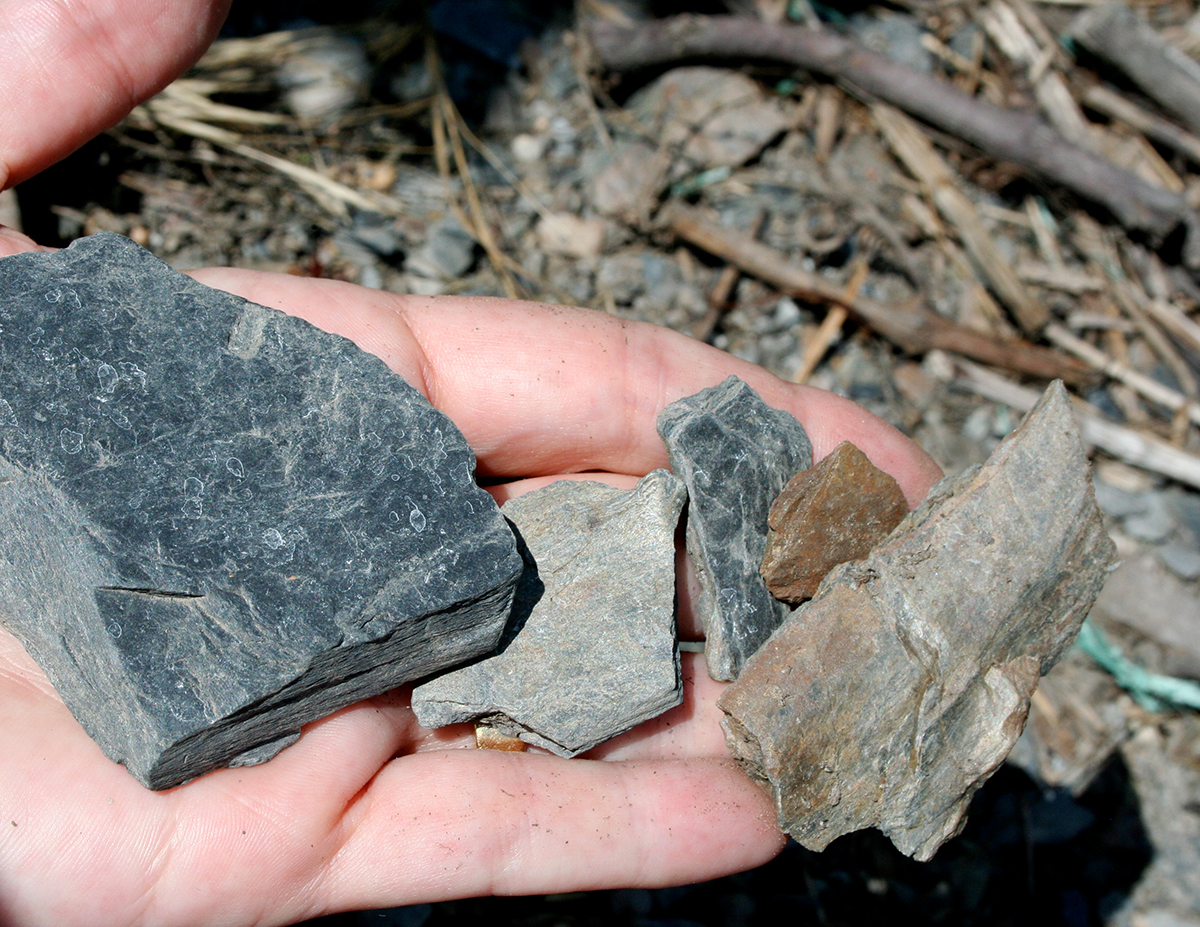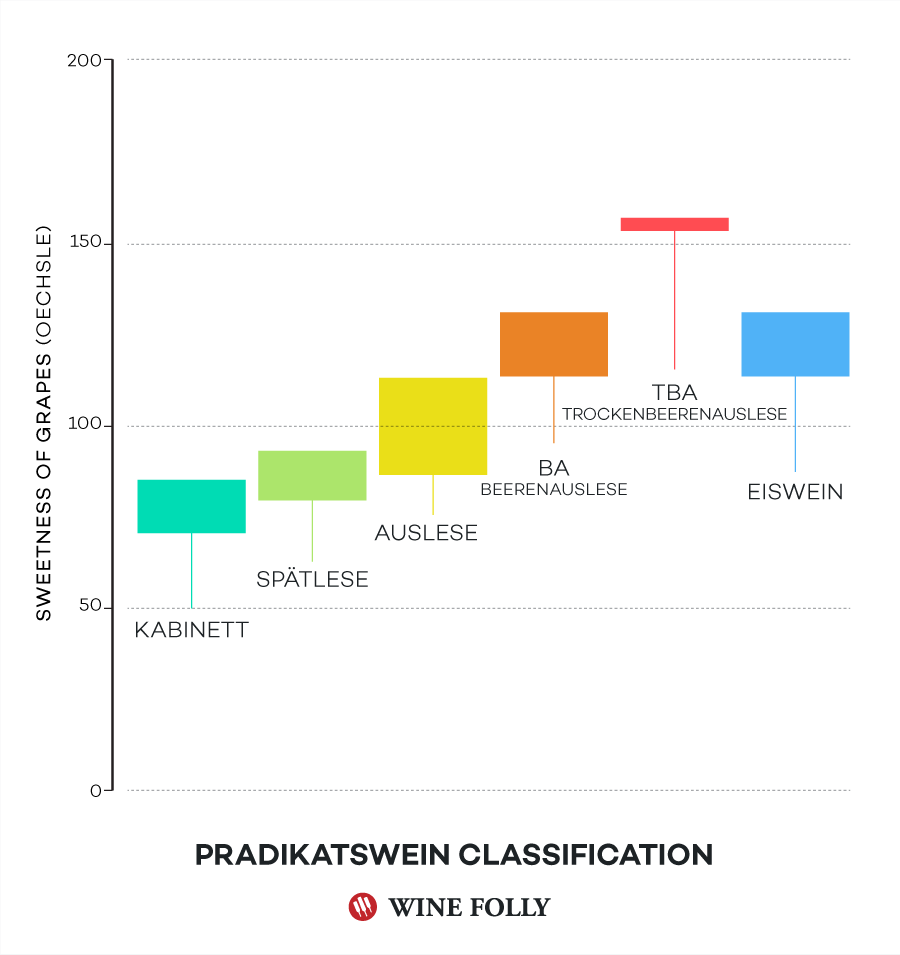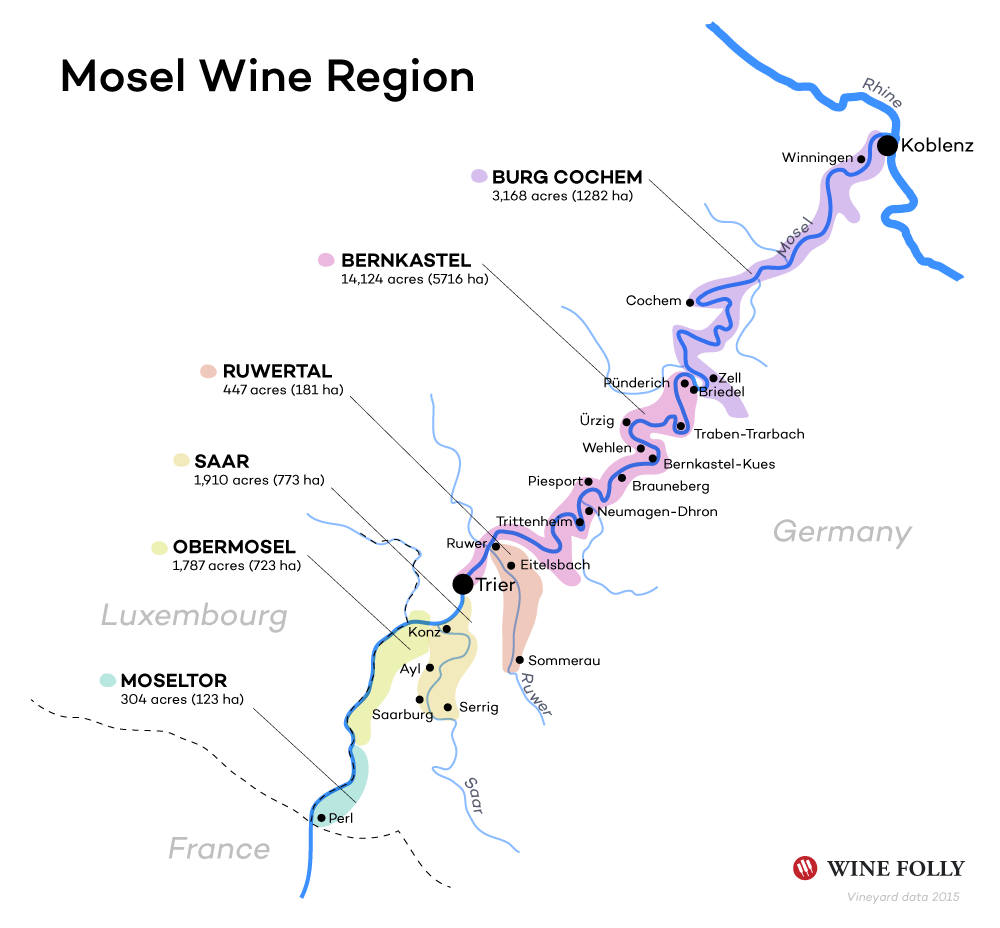The Mosel Valley is pure wine magic: twisty river, crazy-steep vineyards, and crisp, mouthwatering whites. Riesling leads the charge, but there’s more to explore.
Want to decode German wine labels, spot top vineyards, and impress your friends with your bottle picks? You’re in the right place. Let’s get into it.

The Mosel River begins in France and flows into Germany, where it twists sharply for 150 miles (250 km) and empties into the Rhine on its way to the North Sea. It is along this winding river gorge that we find the most classic Riesling wines in the world.
So what makes the Mosel Valley so special for this wine and grape? It’s a combination of geology, geography, and history (the earliest record of Riesling in Germany dates back to 1435) that makes the Mosel wine region unique. Learn how to navigate the German classification system, the vintages, and what areas within the Mosel grow the best grapes.

Grapes of Mosel Valley
The Mosel Valley remains one of the world’s strongholds for white wine, with nearly 91% of its vineyards planted to white varieties. According to Wines of Germany, the region had 8,536 hectares (21,092 acres) under vine in 2022, down from about 8,800 in 2015.
Riesling still dominates, making up around 61% of plantings, but it’s not the only grape worth knowing. In addition, you’ll also find Elbling, Pinot Blanc, Pinot Gris, Kerner, and Auxerrois.
Pinot Noir and Chardonnay also make small but meaningful appearances, often destined for Sekt, German sparkling wine.
Mosel Riesling Tasting Notes
Mosel Riesling ranges from bone-dry to sweet, but its primary aromas and taste profile are distinct and easily identifiable. Mosel Riesling is an excellent choice for blind tasting.
- Color: Wines start out with a pale straw color and become deep yellow as they age.
- Aroma: Young wines have medium-intensity aromas of lime and honeydew, sometimes with slightly reductive smells of plastic or mineral notes. As wines age, they reveal high intensity aromas of honey, apricot, Meyer lemon and gasoline (petroleum). The smell of petrol might be off-putting to some, but to others it’s a classic indicator of German Riesling.
- Taste: The structure of this wine is what makes it so intriguing. It has intensely high acidity, usually balanced with some level of sweetness. Bone-dry wines typically contain around 6–10 g/L of residual sugar, and wines that taste barely off-dry may have as much as 30–40 g/L of RS. The acidity lingers on the palate and tingles. Generally speaking, Mosel wines have low to medium low alcohol ranging from 7.5–11.5% ABV.
How long can it age? German Riesling is known to age well. A wine from a quality producer in a great vintage can last up to 40 years. Even modestly priced wines can age for five years and develop a deep golden hue, with aromatics of honey and petroleum.
Finding Great Mosel Wines by Classification
Classification is the first layer of identifying quality in German wine. There are essentially three classifications to be aware of in the Mosel: Qualitätswein (QbA), Prädikatswein, and VDP.
Qualitätswein (QbA)
A wine produced in the Mosel region that meets a minimum ripeness level is a QbA. However, quality varies in this category, from bulk wines like Black Cat Riesling to decent-quality everyday Riesling wines sourced from all over the Mosel.
Prädikatswein
Prädikatswein bases its quality on ripeness and the amount of grapes affected by noble rot (actually a good thing). Because the region has traditionally been so cool, ripeness has been the primary factor in determining wine quality. Of course, as global warming continues and our demand for dry wine increases, we might see this change; however, for now, Prädikatswein is the most common designation you’ll find in the Mosel Valley. Here are the levels:
- Kabinett: Wines that are dry with around 10% ABV or off-dry (partly sweet) with about 8.5% ABV. You’ll find a great deal of Mosel wines in this category. Many are great.
- Spätlese: “Late Harvest” Wines that range from dry to sweet using riper grapes. Wines labeled ‘Trocken’ will be dry.
- Auslese: “Select Harvest” Grape bunches are hand-selected and have some level of noble rot, which adds subtle notes of beeswax, saffron, and ginger to the taste profile. These wines range from dry to sweet, and the dry styles will have high alcohol (usually around 14%+ ABV)
- Beerenauslese (BA): “Berry Select Harvest” Grapes are hand-picked that have higher levels of noble rot. Wines created at this level are exceptionally sweet.
- Trockenbeerenauslese (BTA): “Dry Berry Select Harvest” The most raisinated noble rot grapes are selected for the highest-end sweet wines of the region.
- Eiswein: Wines can only be labeled ice wine if the grapes naturally freeze and are harvested while frozen.
VDP (Verband Deutscher Prädikatsweingüter)
The VDP is an association of German wine estates that classifies wines by the quality of the vineyard. Specifically, wines are rated as Gutswein (regional wines) all the way up to Grosse Lage, which designates the very best vineyards of Germany. While the association has invited only about 200 wineries in Germany, you will see these vineyard classifications appear on the neck of the bottle.
Finding Great Mosel Wines by Vintage
Next, the second layer of finding great quality in the Mosel is knowing and respecting vintage variation. Very simply, cool-climate wine-growing regions like the Mosel Valley tend to be more susceptible to variable weather conditions. It’s possible that great producers will still make great wines in less favorable vintages, but bulk/value wines usually suffer.
As a general rule, great vintages offer amazing wines at all price points, whereas less impressive vintages (like 2016) require some discerning buying.
| Year | Rating | Notes |
|---|---|---|
| 2024 | 9 | Frost-hammered yields, but what’s left is concentrated and bright, just in tiny quantities. | 2023 | 9 | Juicy, spicy, and crowd-pleasing. Built for early drinking. | 2022 | 8 | Tricky growing season, but the results surprised: elegant and balanced with plenty of energy. | 2021 | 10 | Electric and precise, with thrilling acidity, low alcohol, and Riesling purity at its finest. One for the collectors. | 2020 | 7 | A lighter, cooler year with charm but less depth; great for casual drinking. |
| 2019 | 10 | Textbook vintage: vibrant acidity, perfect ripeness, and serious aging potential across styles. Stock up if you see it. |
| 2018 | 8 | Sunshine in a bottle: ripe, round, and fruit-forward wines that drink well young. |
| 2017 | 8 | A frost-bitten, low-yield year that delivered punchy, concentrated wines. |
| 2016 | 7+ | Tough vintage. Lots of rain and insect problems. |
| 2015 | 10 | Just freakin’ awesome. Please save some for me. |
| 2014 | 9 | A cooler vintage overall, leading to wines with more acidity. It could actually age quite well. |
| 2013 | 8 | Great producers did well, but others, not so much, mainly because of rain and rot problems. |
| 2012 | 7 | Really inconsistent grape bunch development meant only the fastidious producers made out. |
| 2011 | 9+ | A great vintage in the Mosel that was slightly ahead of schedule. Wines have awesome structure and depth. |
| 2010 | 8 | A challenging vintage for ripeness, but some producers expect these wines will last for decades. |
| 2009 | 9 | A long, warm vintage (well, warm for Mosel) that produced rich wines. |
| 2008 | 9 | Maybe not as good as the 2007s, a little more herbaceous and inconsistent, great producers are making age-worthy wines. |
| 2007 | 10 | Wow. Wow. If you can still get it, drink with glee. |
| 2006 | 7+ | This vintage started out awesome, but it didn’t end so well. |
- 10: Buy without limit and cellar (if only budget wasn’t a limit!).
- 9: I would buy and drink, and buy again, and drink again.
- 8: Buy and not take too seriously unless it was from a favorite producer.
- 7: I would be very, very picky with my producer choice. Basically, if you’re a pro, you know how great an unloved vintage can be.
Finding Great Mosel Wines by Sub-Region
Finally, the third layer of finding great quality Mosel wines is understanding the region. Not all of the vineyards here are created equal. The northern latitude (Mosel is along the 50th parallel) means longer days during the growing season, but only certain vineyards are situated to receive these sunshine hours.
There are over 500 named vineyard sites in the Mosel Valley, so unless you’re doing your master’s thesis on the region, it would be a great challenge to memorize them all! Instead, here’s some logic on how to locate where the best vineyards are found:
Areas that face south receive up to 10 times more sunlight (check the sources for details) during parts of the year than those facing north. Also, vineyards located on slopes receive even more horizontal irradiation (sunlight) than the flat lands. It’s no wonder, then, that 40% of the vineyard acres in the Mosel are located on steep slopes (at or over a 30% pitch), and the best vineyards typically face south.
The steepest vineyard in Europe, Calmont, is located in the Mosel at a 68% grade.

What To Look For On The Label
- Producer: This will give you a general impression of the winemaking quality and producer size.
- Village Name: The village/commune will be mentioned first, usually appended with “er” indicating that it’s that particular village’s vineyard. The reason for this is that there are a lot of vineyards called “Würzgarten” (spice garden), “Sonnenuhr” (sundial), “Rosenberg” (rose hill) and “Honigberg” (honey hill).
- Vineyard Name: Want to find the exact vineyard location? We found a great map on Wines of Germany’s website. First, find the city, then zoom in and you’ll see the vineyard names pop up.
- Sub-Region: The six sub-regions of Mosel all offer different expressions of Riesling. While the most planted sub-region of Bernkastel attracts the most attention, the other regions, including Saar and Ruwertal, make great wines as well.

Finding Great Mosel Wines by Soil Type
There are two primary types of slate soils found in the Mosel Valley: blue slate and red slate. Although both soils are relatively poor, the red soil areas generally have more clay, producing a richer, more lush style of Riesling, whereas blue slate wines are generally more floral.
The slate soils offer a few unique benefits to wine growing in the Mosel. First, the vineyards in the Mosel are well-drained, which is good during wet growing seasons. Second, the slates hold heat, which can be beneficial on cool vintages. Finally, the region’s natural microbes (yeasts and bacteria) that thrive in these soils play a role in defining the taste of minerality in Mosel wine.
The geology of the region dates back to the Devonian Period (the Paleozoic Era leading into the 4th major extinction event) when the Mosel area was once an ocean and deposits settled on the sea floor, forming sediment layers as thick as a mile. Over time, the pressure of two supercontinents joining to create Pangea (Gondwana and Laurasia/Euramerica) compressed the sea floor, which metamorphosed into slate.
The slate was later pushed up during the Variscan Orogeny about 100 million years later. The Rhenish Mountains, as they are now called, were carved out by the Mosel River, revealing this geological history. The slate soils here are very poor for most agricultural purposes (they’re hard to farm!), but in the case of wine growing, they produce more structured and concentrated wines.
Last Word
The Mosel Valley is stunningly beautiful. And, since only one-third of the wine is exported, it’s well worth visiting.





